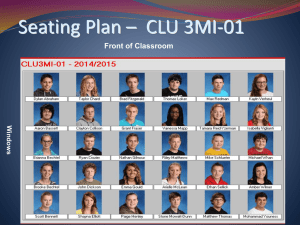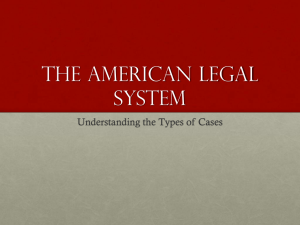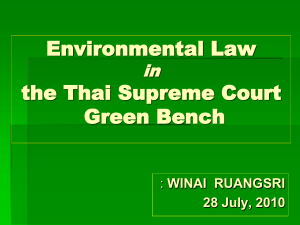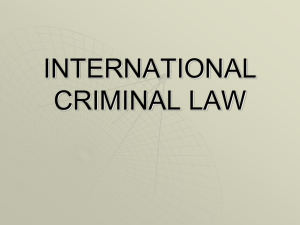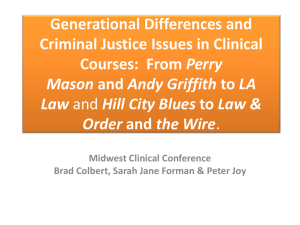First Assignment: Criminal Court Observation
advertisement
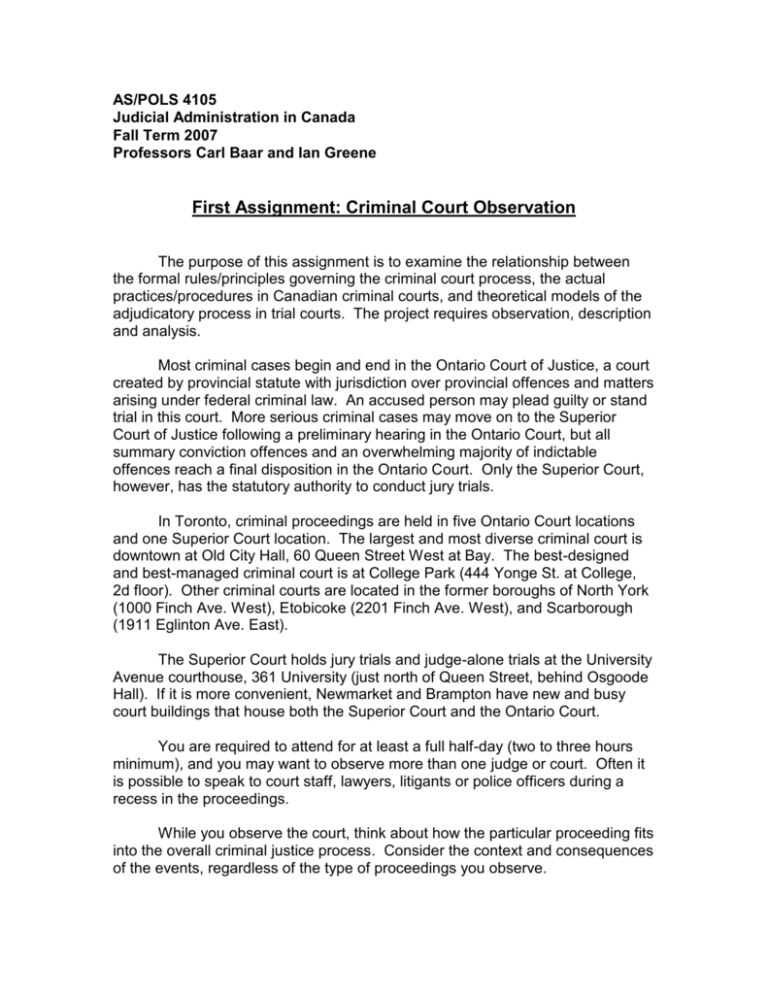
AS/POLS 4105 Judicial Administration in Canada Fall Term 2007 Professors Carl Baar and Ian Greene First Assignment: Criminal Court Observation The purpose of this assignment is to examine the relationship between the formal rules/principles governing the criminal court process, the actual practices/procedures in Canadian criminal courts, and theoretical models of the adjudicatory process in trial courts. The project requires observation, description and analysis. Most criminal cases begin and end in the Ontario Court of Justice, a court created by provincial statute with jurisdiction over provincial offences and matters arising under federal criminal law. An accused person may plead guilty or stand trial in this court. More serious criminal cases may move on to the Superior Court of Justice following a preliminary hearing in the Ontario Court, but all summary conviction offences and an overwhelming majority of indictable offences reach a final disposition in the Ontario Court. Only the Superior Court, however, has the statutory authority to conduct jury trials. In Toronto, criminal proceedings are held in five Ontario Court locations and one Superior Court location. The largest and most diverse criminal court is downtown at Old City Hall, 60 Queen Street West at Bay. The best-designed and best-managed criminal court is at College Park (444 Yonge St. at College, 2d floor). Other criminal courts are located in the former boroughs of North York (1000 Finch Ave. West), Etobicoke (2201 Finch Ave. West), and Scarborough (1911 Eglinton Ave. East). The Superior Court holds jury trials and judge-alone trials at the University Avenue courthouse, 361 University (just north of Queen Street, behind Osgoode Hall). If it is more convenient, Newmarket and Brampton have new and busy court buildings that house both the Superior Court and the Ontario Court. You are required to attend for at least a full half-day (two to three hours minimum), and you may want to observe more than one judge or court. Often it is possible to speak to court staff, lawyers, litigants or police officers during a recess in the proceedings. While you observe the court, think about how the particular proceeding fits into the overall criminal justice process. Consider the context and consequences of the events, regardless of the type of proceedings you observe. Your paper should include the following: (a) (b) (c) Date(s), time(s) and location(s) of your observations. A brief summary of the kinds of proceedings you observed. An analysis of your findings, with appropriate examples. Your analysis should apply and evaluate the typology of adjudicatory processes developed in Cornelius M. Kerwin, Thomas Henderson and Carl Baar, “Adjudicatory Processes and the Organization of Trial Courts,” 70 Judicature 99106 (1986) [in the Course Kit, week 3]. What adjudicatory processes did you observe? What is the basis for your conclusions? Would you make any modifications in the typology and in how it is applied by Kerwin et al.? You may also use these questions to guide your analysis: Were the court proceedings what you expected? Why or why not? Did different judges or lawyers affect the proceedings in a particular way? Did prosecutors (crown counsel) and defence counsel act in the same manner? If you observed a series of cases (e.g. bail hearings), were there any patterns? If you observed judges making sentencing decisions, was this activity consistent with the conclusions of McCormick and Greene at pp. 151-64 of Judges and Judging (Chap. 5, “Judicial Decision-Making: Trial Courts”)? Were people treated equally (e.g. regardless of age, wealth, social class, gender, race, ethnicity, and whether they are in or out of custody)? Were legal rights set out in the Charter observed? Were Charter issues raised? Could you see any difference between the formal authority structure and the actual power relations within the criminal justice system? Length: Due date: Late penalty: 2500 words. Wednesday, October 10, 2007. Two percent per day (out of 100%), including weekends and holidays. POLS/PUBL 5110 Judicial Administration in Canada Fall Term 2007 Professors Carl Baar and Ian Greene First Assignment: Criminal Court Observation The purpose of this assignment is to examine the relationship between the formal rules/principles governing the criminal court process, the actual practices/procedures in Canadian criminal courts, and theoretical models of the adjudicatory process in trial courts. The project requires observation, description and analysis. Most criminal cases begin and end in the Ontario Court of Justice, a court created by provincial statute with jurisdiction over provincial offences and matters arising under federal criminal law. An accused person may plead guilty or stand trial in this court. More serious criminal cases may move on to the Superior Court of Justice following a preliminary hearing in the Ontario Court, but all summary conviction offences and an overwhelming majority of indictable offences reach a final disposition in the Ontario Court. Only the Superior Court, however, has the statutory authority to conduct jury trials. In Toronto, criminal proceedings are held in five Ontario Court locations and one Superior Court location. The largest and most diverse criminal court is downtown at Old City Hall, 60 Queen Street West at Bay. The best-designed and best-managed criminal court is at College Park (444 Yonge St. at College, 2d floor). Other criminal courts are located in the former boroughs of North York (1000 Finch Ave. West), Etobicoke (2201 Finch Ave. West), and Scarborough (1911 Eglinton Ave. East). The Superior Court holds jury trials and judge-alone trials at the University Avenue courthouse, 361 University (just north of Queen Street, behind Osgoode Hall). If it is more convenient, Newmarket and Brampton have new and busy court buildings that house both the Superior Court and the Ontario Court. You are required to attend for at least a full half-day (two to three hours minimum), and you may want to observe more than one judge or court. Often it is possible to speak to court staff, lawyers, litigants or police officers during a recess in the proceedings. While you observe the court, think about how the particular proceeding fits into the overall criminal justice process. Consider the context and consequences of the events, regardless of the type of proceedings you observe. Your paper should include the following: (a) (b) (c) Date(s), time(s) and location(s) of your observations. A brief summary of the kinds of proceedings you observed. An analysis of your findings, with appropriate examples. Your analysis should apply and evaluate the typology of adjudicatory processes developed in Cornelius M. Kerwin, Thomas Henderson and Carl Baar, “Adjudicatory Processes and the Organization of Trial Courts,” 70 Judicature 99106 (1986) [in the Course Kit, week 3]. What adjudicatory processes did you observe? What is the basis for your conclusions? Would you make any modifications in the typology and in how it is applied by Kerwin et al.? You may also use these questions to guide your analysis: Were the court proceedings what you expected? Why or why not? Did different judges or lawyers affect the proceedings in a particular way? Did prosecutors (crown counsel) and defence counsel act in the same manner? If you observed a series of cases (e.g. bail hearings), were there any patterns? If you observed judges making sentencing decisions, was this activity consistent with the conclusions of McCormick and Greene at pp. 151-64 of Judges and Judging (Chap. 5, “Judicial Decision-Making: Trial Courts”)? Were people treated equally (e.g. regardless of age, wealth, social class, gender, race, ethnicity, and whether they are in or out of custody)? Were legal rights set out in the Charter observed? Were Charter issues raised? Could you see any difference between the formal authority structure and the actual power relations within the criminal justice system? Length: Due date: Late penalty: 2500 words. Wednesday, October 10, 2007. Two percent per day (out of 100%), including weekends and holidays.


